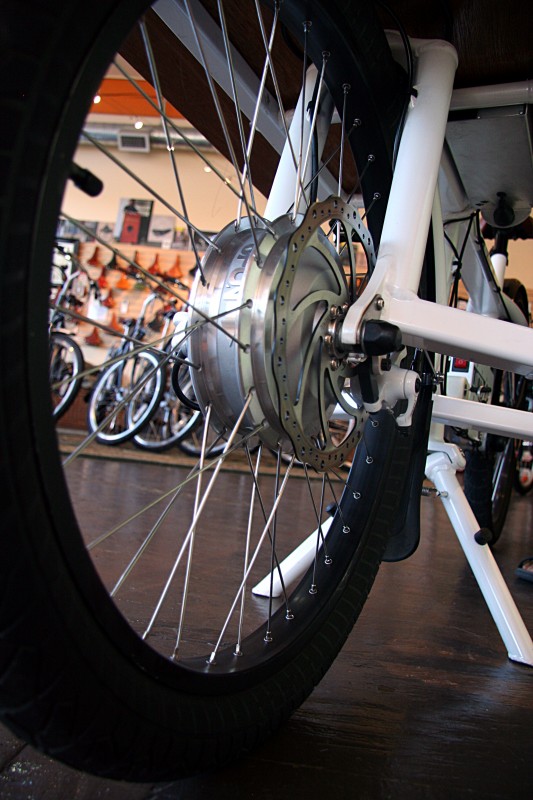
(Photos © M.Andersen/BikePortland)
Some cargo bikes, built for personal freight and boxes, are low and light. Others, built for kids and errands, are deep and sturdy.
The cargo bike Neal Saiki is about to bring to market has a new formula. It’s built to operate at the height that most of the world’s work actually gets done: approximately three feet in the air.
But for the 2×4 cargo e-bike, which Saiki showed off in Portland this week, a waist-high cargo bed is just the beginning.

creator’s full weight just fine while parked at Clever Cycles Tuesday.
Saiki, a 27-year veteran of the bike building industry who’s specialized in electric vehicles since 2004, launched his latest creation last week with a very specific market in mind: European postal carriers.
“They need to have the letters in front of them because they need to sort them,” explained Saiki, who is based in Santa Cruz, Calif. The high bed means that workers don’t need to repeatedly bend over, potentially hurting their backs, to fetch the cargo.
Saiki and his wife and business partner, Lisa Saiki, took their prototype to the Eurobike trade show last week and drew interest from the Belgian, German and Swiss post offices, all of which are considering replacing fully motorized vehicles with partially human-powered ones. But they’re also targeting local delivery companies, nongovernmental aid organizations working in remote areas, and individual consumers.
This is an industrial-quality vehicle with a cost to match: The 68-pound 2×4 will retail for $4,600. Saiki said Tuesday that he expects “100 to 200 bikes to be ready around January to February.”
I got to take a close look at the new contraption. Let’s take the features one by one.
Battery. “The battery has been the problem for all of these electric vehicles,” Saiki said, citing the risk of unreliability or malfunction. Informed by Saiki’s work at his last startup, electric vehicle company Zero Motorcycles, Saiki chose a new Samsung variety that he called “the first completely safe lithium ion battery.” “You can overcharge it, you can put it in an oven, you can crush it and you can pierce it with a steel rod,” he said. NTS says it’s good for 500 to 1000 full recharges and can help you move 10,000 miles for a cost of about $30.
The company offers a lifetime service warranty and will swap in a new battery at any time for half the cost of a new battery (the new price is currently listed at $900). The water-sealed battery is modular, so welding isn’t necessary for service.
Electric assist. Most e-bikes put their electric drive at the back wheel. In order to let the 2×4 easily haul hundreds of pounds up steps and over uneven surfaces, it assist works at the front hub, giving the vehicle the delicate feeling of a power steering car.
Throttle control. The motor is activated by pedaling, and shuts off automatically after a hand brake or two seconds of inactivity. However, a simple panel on the left handlebar lets you boost, increase or decrease power manually: “Push the button to climb any curb,” Saiki says. The 2×4’s 250-watt engine will assist you up to 20 mph.
Wheels. The 2×4 is built for 300-year-old curbs and cobblestones: It has two large wheels, a 50.4″ wheelbase and the fattest tires I’d ever seen on a bike. Relying on two wheels, instead of three, is another advantage when cornering and taking curbs in an urban environment:
Kickstand. Saiki describes himself as a “kickstand maniac,” and this one struck me as being designed with particular care. Each hollow tube in the kickstand folds independently, with sealed cartridge bearings and a springy thunk into place when it’s down. To fold it back up, you can just get on and start pedaling.
Mirror. A wide, curving, adjustable rear-view mirror is affixed not to the handlebars but to the frame itself.
Drive belt. “I personally don’t like maintenance,” Saiki said. “Our goal is just to make a bike that you never think about.” The carbon Gates center track belt drive, which connects to an 8-gear hub on the back wheel, doesn’t require oil and doesn’t acquire much grit on the road. Saiki rubbed his hand across the belt that he said he’d ridden 1,000 miles on, showing that it wasn’t leaving a mark on his skin.
The bike’s unusual characteristics — minimal maintenance, relatively few moving parts, maximal adaptability to terrain — are intended to add up to a vehicle with day-after-day reliability and effortless utility.
“This is like buying a 1940s Cadillac,” Saiki said. “These things last forever.”
They’ll be sold directly on the NTS website and may also be available via local cargo-bike specialists like Clever Cycles and Splendid Cycles; call for availability once the bikes are in production next year. The Saikis start the second stop of their U.S. launch tour, Seattle, today.









